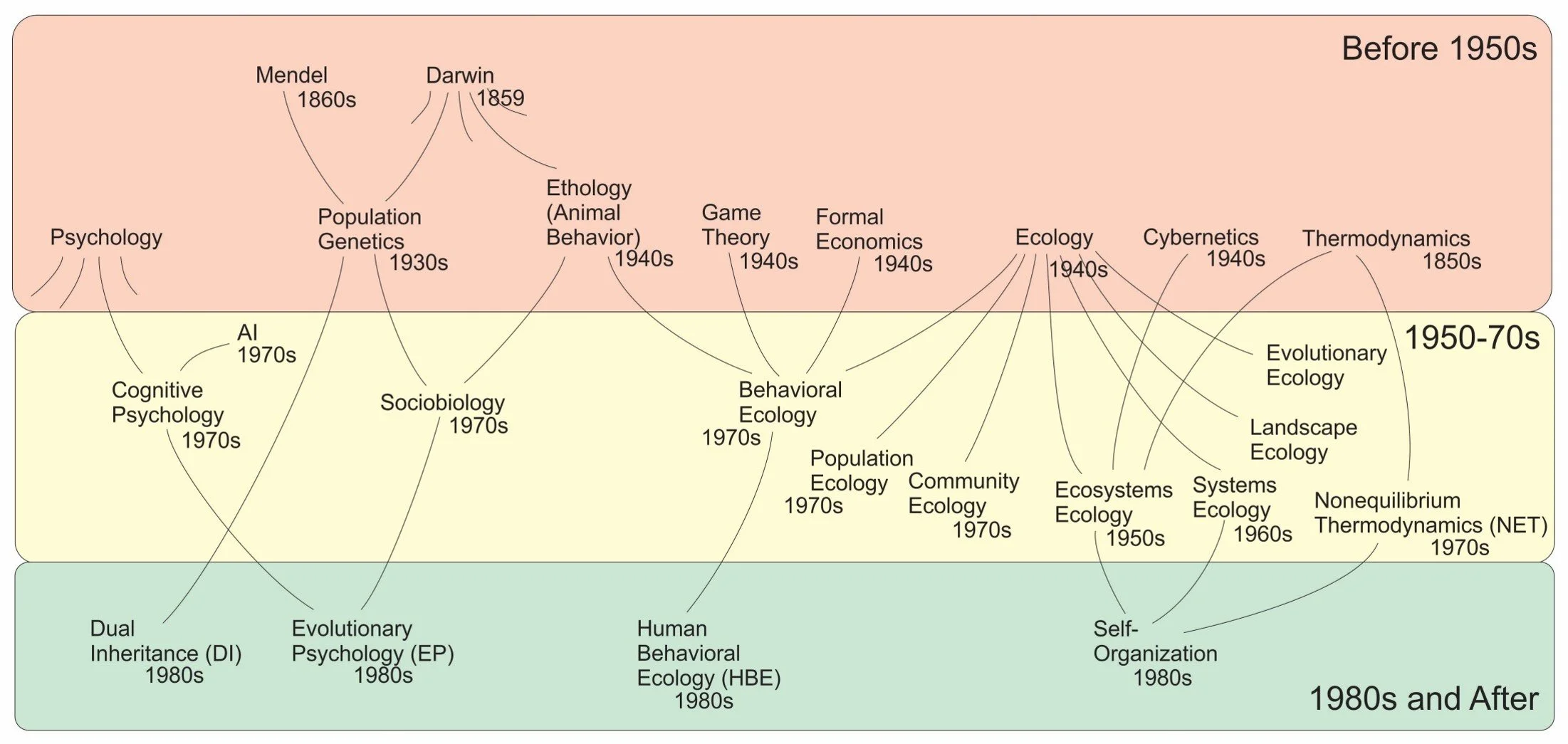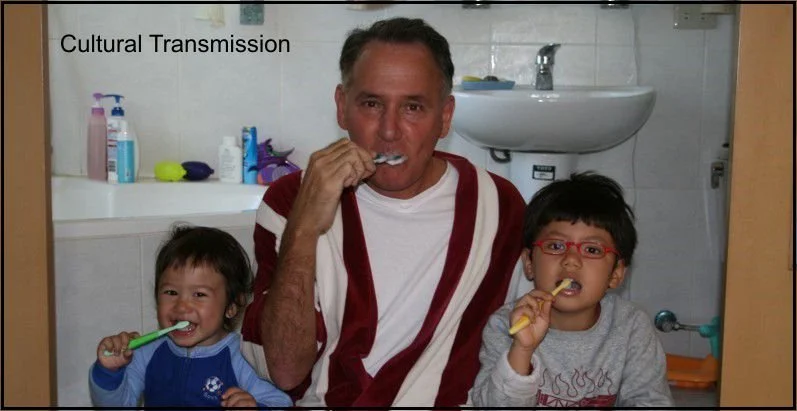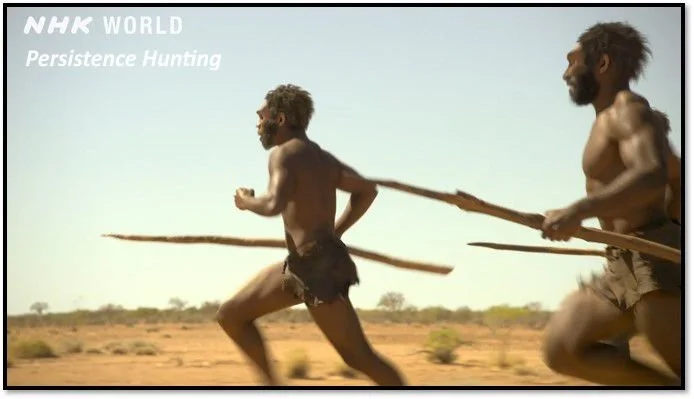The New Cultural Evolution
In my graduate seminar on evolutionary theory in the 1990s, taught by the archaeologist Bill Keegan, we all discovered together the new cultural evolution. Keegan was trained in evolutionary theory by Allen Johnson and Tim Earle at UCLA. There he also learned of the human behavioral ecology (HBE) of Winterhalder and Smith, and wrote an article for the American Anthropologist titled “The optimal foraging analysis of horticultural production (1986).” In our seminar class, we explored the HBE of Winterhalder and Smith, the evolutionary psychology (EP) of Cosmides and Tooby, and also, I believe, the dual inheritance (DI) of Boyd and Richerson. Bill became my dissertation chair. My dissertation included a section in which I adapted the traditional evolutionary anthropology of Johnson and Earle (1989) to the systems diagramming of HT Odum, another PhD committee member. When I started my professor job at Tzu Chi University in Taiwan, I wanted to know more about the approaches of the new cultural evolution, so I spent some time working through the literature and creating a graduate class, Culture and Evolution. Eventually that work led to this undergraduate class.
What joins together these newer approaches is their desire to emphasize the neo-Darwinian tradition, i.e., a focus on ‘reproductive fitness’. Its target was thus individuals and not human-nature systems. This approach is sometimes distinguished from the traditional cultural evolution with the label ‘micro’, and thus the micro-macro distinction.
If modern humans exhibit the dispositions studied by HBEs, DIs, and EPs, in this class I begin by asking the most basic questions, when did these dispositions appear/evolve in the human line, and what is their evidence in our human primate relatives? The class therefore begins with primatology. It then moves to paleoanthropology. The first half of the class is completed with introductions to EP and HBE.
The second half of the class is directly focused on ‘culture’ as a human-unique ability. Can it be studied within a neo-Darwinian tradition that treats cultural traits like genes. Cultural traits that are transmitted not by sexual reproduction, but by social learning, a second or ‘dual’ channel of inheritance, hence DI. In my expanded view, DIs study the mechanisms of transmission, the strategies (biases), the sources, the means, the mediums, and the maintenance of cultural transmission. I am responsible for the last two ‘M’s, mediums and maintenance in my hierarchy of cultural information forms (Abel 2014).
My department wanted me to call this class Psychological Anthropology, and some of my ppts will refer to that, but here I am giving it my preferred title, the New Cultural Evolution. What differentiates this class from the graduate class, Culture and Evolution? The graduate class includes a long section of ppts on the expanded evolutionary synthesis of complex self-organizing systems. Including that material here made the class too long. This class was more recently updated and improved. It embodies a more coherent narrative of the topics. It also includes my latest research into cultural transmission and the hierarchy of information cycles. You can find that in the research page, Culture in Cycles.
Lectures
Introduction
Introduction to the New Cultural Evolution
This ppt briefly introduces important terminology: reproductive fitness, inclusive fitness, altruism, reciprocal altruism, language, cheating, free riding, indirect reciprocity, reputation, strong reciprocity, costly signaling, social learning, cumulative culture, dual inheritance, and social norms. It introduces these terms in the context of ‘cooperation’. This is intentionally startling to the students in an ‘evolution’ class who might be expecting topics like competition, dominance, and the struggle to survive. The new cultural evolution is not the old.
Evolutionary Explanations for Thought and Behavior
Many of the terms that were introduced in the first ppt come from biologists who have studied non-human primates for decades. We will look closely at these: primate sociality and the advantage of living in groups (group living), altruism and kin selection, mating strategies (female and male), reproductive strategies, and sexual selection. When we look at group living, we introduce terms for mating systems that will also be applied to humans: monogamy, polyandry, and polygyny. When and why has altruistic behavior evolved in primates. Females have primary responsibility for the survival of their offspring, what strategies do females employ to aid success. What are sexual selection and male mating strategies. We then begin to ask, how are humans similar and different.
First Culture - Gene-Culture Coevolution
We have looked at our living primate relatives. We now look at the human evolutionary line, back to Australopithecus. The ppt is titled gene-culture coevolution because we see clear evidence of coevolution among Australopithecus and then forward to our Homo ancestors. We will look closely at Homo erectus. We use the term coevolution because we see simultaneous body changes and the appearance of culture (stone tools, food preparation, gestural and spoken language, cooperation, etc). We see that cultural traits persist and improve, termed cumulative culture.
Both EP and HBE have roots in Ethology (the evolutionary study of animal behavior). In the 1970s, two new fields emerged, Sociobiology and Behavioral Ecology. In the 1980s, from Sociobiology came Evolutionary Psychology (EP), while from Behavioral Ecology came Human Behavioral Ecology (HBE). See the family tree at the bottom of this webpage. Behavior Ecology uses quantitative methods from ‘formal economics’ to produce methodologies like ‘optimal foraging theory’. Conflict and competition between animals was an important focus. Sociobiology began with studies of social animals and social insects, applying neo-Darwinian theory to explain behavior. In the 1980s, topics like altruism, inclusive fitness, reciprocal altruism and others became important parts of explanation. Many sociobiologists adopted the psychology of innate mechanisms, and the result was Evolutionary Psychology.
Innate Psychological Mechanisms
What are the proposed innate psychological mechanisms of the EPs? There are mechanisms for the individual (like facial processing, cheater detection, male and female biases for mate selection, and language abilities such as common ground and joint attention) and for the group (like ethnic psychology, norm psychology, kin recognition, status psychology (dominance and prestige), and others). There are innate ‘ecological’ mechanisms, innate fears of snakes and spiders. Some interesting proposals are for ritualistic synchrony (in dancing, singing, chanting, drumming, or marching), and innate musicality (for musical-rhythmic and harmonic communication). I prefer the domain-general propensities that facilitate basic needs, tendencies to think in particular ways: propensities for attention, memory, and learning of certain things and not others.
Human Behavioral Ecology Summary
HBE studies human behavior from an adaptive perspective. HBE is especially focused on plasticity, i.e., individual and social learning. It therefore can change much faster than genes in the EP model. Current research topics are production (foraging and other productive activity), reproduction (mate choice decisions, etc.), and distribution / cooperation (resource sharing and social structure). Models are quantitative, coming from formal economics and game theory. Research foci are many of the same in EP.
The Influence of Culture on Thought and Behavior
The Meaningful Content of Culture
The second half of the class is addressed to the influence of culture on thought and behavior. Many interesting topics are social learning, norm psychology, kinship, rituals, prestige hierarchies, ethnic psychology, cultural transmission, cultural models, and other topics. But before we get to that, I felt it was necessary to discuss the meaningful ‘content’ of culture that we will address in the formal models that follow. First, what is culture? Anthropology has proposed many ways to see culture: schemas, cultural codes, habitus, cultural models, etc. I use cultural models frequently in the class. We look at a cultural model of sailing in Micronesia, a model of home heat control, and a model of Ecuadorian illness stories. In the final ppt for the class, we will come back once more to meaningful models in culture.
Culture and Cultural Transmission
This week we explore the formal, abstract properties of culture and the process of cultural evolution. We look at ‘mechanisms’ of social learning, ‘strategies’ or ‘learning biases’ of cultural transmission, ‘sources’ of transmission, ‘means’ of transmission, and two topics that come from my research, ‘mediums’ of cultural transmission, and the ‘maintenance’ of information. Social learning is key. Social norms are commonly proposed units of transmission. Proposed ‘mediums’ of cultural transmission are my hierarchy of communication forms. The ‘maintenance’ of information is via information cycles. An excellent ppt.
Dual Inheritance, Memetics, and Information
This is the homebodies and hellraisers ppt, with a quantitative demonstration of dual inheritance. Other topics are learning biases of cultural transmission. Then a section on memetics, an approach that is widely discredited. Then the story of prosocial religions and polygyny.
Social Norms, Kinship, Rituals, and Ethnic Psychology
Topics for this ppt are social norms, ethnic psychology, kinship, communal rituals and synchrony, and moral emotions. All of these have a basis in our innate psychology (see that ppt), but every society exhibits that basis in a culture-unique way, i.e., every culture has different norms, different kinship terms, different beliefs about ethnicity, different rituals, and differently expressed emotions. Social norms are an important piece of cultural evolution research. We seem to have evolved abilities to infer and remember norms, and evolved motivations to follow them. Marriage creates kinship, cultures have norms for behavior in marriage. Emotions are the ‘conductors’ of our mental orchestra. Culture provides us with the morality of our emotions. Ha, the ppt ends with a section, “Why anthropologists do not like ‘norms’.”
The ‘Functions’ of Symbolic Culture
What is culture for? Symbolic culture provides control, control of the production of material culture, and the satisfaction of our ‘basic needs’ of getting a mate, investing in offspring, defending our homes and families, and finding food. Our learning of culture is statistical (the ‘means’), and the result is both explicit and implicit cultural knowledge. We construct causal models. We imitate and over imitate (interesting stories), we ‘think together’ in collective brains. Energy inputs to society determine the number of scales of ‘mediums’ of culture that emerge through deep time. And other great topics, a bit of a hodgepodge.
Last but not least, I wanted to give the students some more interesting formations of culture than simple norms. Anthropologists have a long history of proposing objects of culture. Examples are habitus and cultural capital from Bourdieu, or discursive formations from Foucault. This ppt is shorter versions of my theory ppts for those two famous authors. The ppt finishes by asking how those two famous authors would address the topics of the class. I suggested that Foucault would hate it since he rejected social norms of sexuality, etc, and since he rejected the institutions of religion, medicine, criminal justice, and psychiatry. But the answer becomes a bit more nuanced. Bourdeau is easier to fit into the class. Cultural capital is a tool of intrasexual selection, and clothing and tastes are ‘social markers’ for ethnic group identity. Perhaps ‘dispositions’ are the smallest unit of knowledge for Bourdieu. Habitus is a system of dispositions. They are implicit knowledge, a ‘feel for the game’. They are learned socially, etc. Great stuff to think about.
Biological Paradigms Family Tree
Below is another family tree, smaller but similar to my ‘anthropologist/paradigm’ family tree in the theory class. It should be self-explanatory. If you cannot see it, you can download it.


